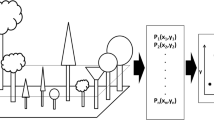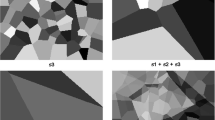Abstract
Due to the long tradition of the Braun-Blanquet approach, many relevés using this approach have been made. Recent developments in vegetation-plot databases provide an opportunity to effectively use these relevés to study ecological problems as well. Opinions differ, however, concerning the applicability of these datasets, often with their use being restricted to exploration and hypothesis generation only.
We assert that preferential sampling, which is characteristic of the Braun-Blanquet approach, means using a special definition of statistical population rather than non-random sampling. We present a case study, where consequences of using a preferential and non-preferential definition of statistical population are studied. Although the traits of stands that are preferred or avoided by the phytosociologist during preferential sampling can be identified, there are no general rules that could predict the difference between the preferential and non-preferential datasets obtained for the same object.
Similar content being viewed by others
References
Borhidi A. (1995): Social behaviour types, the naturalness and relative ecological indicator values of the higher plants in the Hungarian Flora.Acta Bot. Hung. 39: 97–181.
Borhidi A. (2003):Plant communities of Hungary. Akadémiai Kiadó, Budapest.
Braun-Blanquet J. (1928):Pflanzensoziologie. Springer Verlag, Wien.
Brisse H., de Ruffray P., Grandjouan G. &Hoff M. (1995): The Phytosociological Database “SOPHY” Part 1: Calibration of indicator plants, Part II: Socio-ecological classification of the relevés.Ann. Bot. (Rome) 53: 177–223.
Chytrý M. (2001): Phytosociological data give biased estimates of species richness.J. Veg. Sci. 12: 439–444.
Chytrý M., Tichý L. &Roleček J. (2003): Local and regional patterns of species richness in Central European vegetation types along the pH/calcium gradient.Folia Geobot. 38: 429–442.
Chytrý M. &Rafajová M. (2003): Czech National Phytosociological Database: basic statistics of the available vegetation-plot data.Preslia 75: 1–15.
Csontos P. (1996):Az aljnövényzet változásai cseres-tölgyes erdők regenerációs szukcessziójában (Regeneration succession of sessile oak — turkey oak forests: Processes in the herb layer). Scientia Publishing, Budapest.
Dierschke H. (1994):Pflanzensoziologie. Verlag Eugen Ulmer, Stuttgart.
Duckworth J.C., Bunce R.G.H. &Malloch A.J.C. (2000): Vegetation gradients in Atlantic Europe: the use of existing phytosociological data in preliminary investigations on the potential effects of climate change on British vegetation.Global Ecol. Biogeogr. 9: 187–199.
Ewald J. (2001): Der Beitrag pflanzensoziologischer Datenbanken zur vegetationsökologischen Forschung.Ber. Reinhold Tüxen Ges. 13: 53–69.
Font X. &Ninot J.-M. (1995): A regional project for drawing up inventories of flora and vegetation in Catalonia (Spain).Ann. Bot. (Rome) 53: 99–105.
Hallgren E., Palmer M.W. &Milberg P. (1999): Data diving with cross-validation: an investigation of broad-scale gradients in Swedish weed communities.J. Ecol. 87: 1037–1051.
Hahn I. &Scheuring I. (2003): The effect of measurement scales on estimating vegetation cover: a computer experiment.Community Ecol. 4: 29–33.
Hennekens S.M. &Schaminée J.H.J. (2001): TURBOVEG, a comprehensive database management system for vegetation data.J. Veg. Sci. 12: 589–591.
Holeksa J. &Wozniak G. (2005): Biased vegetation patterns and detection of vegetation changes using phytosociological databeses. A case study in the forest of the Babia Góra National Park (the West Carpathians, Poland).Phytocoenologia 35: 1–18.
Horváth F., Dobolyi Z.K., Morschhauser T., Lőkös L., Karas L. &Szerdahelyi T. (1995):FLÓRA database 1.2. MTA-ÖBKI & MTM Növénytára, Vácrátót.
Kennedy K.A. &Addison P.A. (1987): Some consideration for the use of visual estimates of plant cover in biomonitoring.J. Ecol. 75: 151–157.
Kent M. &Coker P. (1992):Vegetation description and analysis. A practical approach. John Wiley & Sons, Chichester.
Kienast F., Wildi O. &Brzeziecki B. (1998): Potential impacts of climate change on species richness in mountainforests — An ecological risk assessment.Biol. Conservation 83: 291–305.
Kovács-Láng E., Kröel-Dulay Gy., Kertész M., Fekete G., Bartha S., Mika J., Dobi-Wantuch I., Rédei T., Rajkai K. &Hahn I. (2000): Changes in the composition of sand grasslands along a climatic gradient in Hungary and implications for climate change.Phytocoenologia 30: 385–407.
Kröel-Dulay Gy., Ódor P., Peters D.P.C. &Hochstrasser T. (2004): Distribution of plant species at a biome transition zone in New Mexico.J. Veg. Sci. 15: 531–538.
Kun A. &Ittzés P. (1995): ASeseli leucospermum W. et K. és a nyílt dolomitsziklagyep (Seseli leucospermo-Festucetum pallentis) előfordulása szarmata mészkövön (Occurence ofSeseli leucospermum W. et K. andSeseli leucospermo-Festucetum pallentis community on sarmatian limestone).Bot. Közlem. 82: 27–34.
Legendre P. &Legendre L. (1998):Numerical ecology. Ed. 2. Elsevier, Amsterdam.
Legendre P. &Anderson M.J. (1999): Distance-based redundancy analysis: Testing multispecies responses in multifactorial ecological experiments.Ecol. Monogr. 69: 1–24.
Mirkin B.M. (1989): Plant taxonomy and syntaxonomy: a comparative analysis.Vegetatio 82: 35–40.
Mucina L. (1997): Classification of vegetation: Past, present and future.J. Veg. Sci. 8: 751–760.
Mucina L., Bredenkamp G.J., Hoare D.B. &McDonald D.J. (2000): A national vegetation database for South Africa.S. African J. Sci. 96: 497–498.
Mucina L., Rodwell J. S., Schaminée J.H.J. &Dierschke H. (1993): European vegetation survey: current state of some national programmes.J. Veg. Sci. 4: 429–439.
Pignatti S., Dominici E. &Pietrosanti S. (1997): European vegetation survey — from the methodological discussion to the first approximation.Ann. Bot. (Rome) 45: 5–16.
Podani J. (2000):Introduction to the exploration of multivariate biological data. Backhuys Publishers, Leiden.
Rédei T. (2005):A növényi fajkészlet eloszlása nyílt szárazgyepekben (The distribution of plant species pool in open dry grasslands). PhD. Thesis, Budapest.
Rédei T., Botta-Dukát Z., Csiky J., Kun A. &Tóth T. (2003): On the possible role of local effects on species richness of acidic and calcareous rock grasslands in northern Hungary.Folia Geobot. 38: 453–467.
Rodwell J.S. (1995): The European Vegetation Survey questionnaire: an overview of phytosociological data, vegetation survey programmes and databases in Europe.Ann. Bot. (Rome) 53: 87–98.
Rodwell J.S., Schaminée J.H.J., Mucina L., Pignatti S., Dring J. & Moss D. (2002):The diversity of European vegetation. An overview of phytosociological alliances and their relationships to EUNIS habitats. EC-LNV. Report EC-LNV. nr. 2002/054, Wageningen.
Ruprecht E. &Botta-Dukát Z. (1999): Long-term vegetation textural changes of three fen communities near Cluj-Napoca (Romania).Acta Bot. Hung. 42: 263–281.
Sokal R.R. &Rohlf F.J. (1981):Biometry. The principles and practice of statistics in biological research. Ed. 2. Freeman, New York.
Sprent P. &Smeeton N.C. (2001):Applied nonparametric statistical methods. Chapman & Hall/CRC, Boca Raton.
SPSS Inc. (1999):SPSS base 10.0 user’s guide. SPSS Inc., Chicago.
Sykes J.M., Horrill A.D. &Mountford M.D. (1983): Use of visual cover assessments as quantitative estimators of some British woodland taxa.J. Ecol. 71: 437–450.
ter Braak C.J.F. &Šmilauer P. (1998):CANOCO reference manual and user’s guide to Canoco for Windows. Centre for Biometry, Wageningen.
Westhoff V. &van der Maarel E. (1980): The Braun-Blanquet approach. In:Whittaker R.H. (ed.),Classification of plant communities, Junk, The Hague.
Zar J.H. (1999):Biostatistical analysis. Ed. 4. Prentice Hall, Upper Saddle River, New Jersey.
Author information
Authors and Affiliations
Corresponding author
Rights and permissions
About this article
Cite this article
Botta-Dukát, Z., Kovács-Láng, E., Rédei, T. et al. Statistical and biological consequences of preferential sampling in phytosociology: Theoretical considerations and a case study. Folia Geobot 42, 141–152 (2007). https://doi.org/10.1007/BF02893880
Received:
Revised:
Accepted:
Issue Date:
DOI: https://doi.org/10.1007/BF02893880




